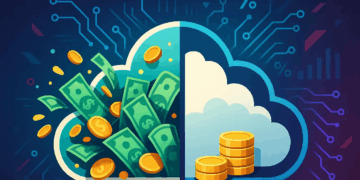The promise of cloud computing is immense: infinite scalability, flexibility, and a pay-as-you-go model that seems to offer unparalleled efficiency. However, for many businesses, this promise has been met with a harsh reality: skyrocketing cloud bills that spiral out of control. This phenomenon, often referred to as “cloud waste,” is a major pain point for companies of all sizes. Cloud Cost Optimization Secrets is a comprehensive guide to understanding and mastering the strategies and tools that can help you rein in your cloud spending without sacrificing performance or innovation. This article will provide a deep dive into the principles of FinOps (Cloud Financial Operations), the key areas where costs can be managed, and the new technologies and methodologies that are defining the next chapter of cloud cost management. By implementing these secrets, you can transform your cloud from a financial liability into a powerful engine for business growth.
The Anatomy of Cloud Waste

To effectively optimize your cloud costs, you first need to understand where the waste is coming from. Cloud waste is not a single problem but a collection of inefficiencies that, when combined, can lead to a massive overspend. A recent report by a major cloud consulting firm found that as much as 30% of all cloud spending is wasted.
A. Idle and Underutilized Resources: This is the most common form of cloud waste. It occurs when a virtual machine, a database, or a storage service is running but is not being used. A developer may spin up a new server for a project and then forget to turn it off when the project is complete. A company may provision a massive database for a seasonal spike in traffic and then forget to downscale it when the traffic returns to normal. This waste is a low-hanging fruit for cost optimization.
B. Oversized Instances and Services: Many businesses, in an effort to ensure their applications have enough power, provision more resources than they actually need. This “oversizing” can lead to a massive overspend. A virtual machine that is running at 10% of its capacity is a clear sign of waste. The key is to find the “Goldilocks zone,” where the resources are just right for the application’s needs.
C. Unmanaged Data Storage: Data is growing at an exponential rate, and so is the cost of storing it in the cloud. A significant amount of this storage is wasted on old backups, obsolete data, or simply a lack of a data lifecycle management policy. A company may be paying a premium for fast-access storage for data that is rarely, if ever, accessed.
D. Suboptimal Pricing Models: Cloud providers offer a variety of pricing models, from on-demand to reserved instances and savings plans. A company that is not using the right pricing model for its workloads is likely overspending. For example, a company that is running a long-term, predictable workload on a high-cost, on-demand instance is a clear sign of a suboptimal pricing model.
E. Lack of a “Culture of Cost”: In many organizations, the developers who are provisioning cloud resources are not the ones who are paying the bill. This can lead to a lack of a “culture of cost” where developers are not incentivized to be mindful of their cloud spending. The most successful companies are those that have a culture where every employee is aware of the cost implications of their decisions.
The Principles of FinOps (Cloud Financial Operations)
The solution to cloud waste is a new discipline known as FinOps, or Cloud Financial Operations. FinOps is a cultural and operational framework that brings together finance, technology, and business teams to manage cloud spending. It is built on three core principles.
A. Inform: The first principle of FinOps is to inform everyone in the organization about cloud spending. This includes providing engineers with real-time visibility into their cloud usage and costs, and providing finance teams with a clear and understandable breakdown of cloud spending. The goal is to create a shared understanding of how money is being spent in the cloud.
B. Optimize: The second principle is to optimize cloud spending. This includes a variety of techniques, such as identifying and eliminating idle resources, right-sizing virtual machines and services, and using the right pricing models for different workloads. Optimization is not a one-time event; it is an ongoing process that requires continuous monitoring and a commitment to efficiency.
C. Operate: The third and most important principle is to operate in a new way. This includes creating a culture of cost, where every employee is incentivized to be mindful of their cloud spending. It also includes creating new processes and automation to manage cloud costs, such as an automated system that shuts down idle resources or a policy that requires a developer to get approval before provisioning a new, high-cost service. FinOps is a new way of working that is as much about culture as it is about technology.
Key Optimization Strategies and Secrets

Now that you understand the principles of FinOps, here are some of the most effective strategies and secrets for optimizing your cloud costs.
A. Eliminate Cloud Waste: This is the lowest-hanging fruit and can lead to immediate and significant cost savings.
- Automate Shutdowns: Use automation to automatically shut down idle and underutilized resources, such as development and testing environments that are not needed after business hours.
- Data Lifecycle Management: Implement a data lifecycle management policy that automatically moves old data from high-cost, fast-access storage to low-cost, cold storage.
- Delete Obsolete Data: Regularly audit and delete obsolete data, such as old backups and logs, that are no longer needed.
B. Right-Size Your Resources: This is the process of ensuring that your virtual machines and services are a perfect match for the needs of your application.
- Continuous Monitoring: Use a cloud monitoring tool to continuously monitor the CPU and memory usage of your virtual machines. If a machine is running at a low utilization rate, you can downsize it to a smaller, more cost-effective instance.
- Use the Right Service: Cloud providers offer a wide variety of services, from a simple virtual machine to a fully managed database. By using the right service for the job, you can significantly reduce your costs.
C. Leverage the Right Pricing Models: Cloud providers offer a number of pricing models, and using the right one for your workloads can lead to significant cost savings.
- Reserved Instances and Savings Plans: For long-term, predictable workloads, a reserved instance or a savings plan can offer a massive discount compared to an on-demand instance.
- Spot Instances: For workloads that can tolerate interruptions, a spot instance can offer an even deeper discount. This is a great option for a company that is running a non-critical workload, such as a data processing job.
- Serverless and FaaS: The serverless model, where you only pay for the compute time that you use, is an incredibly cost-effective option for applications that have unpredictable traffic patterns.
D. Utilize Cost Management Tools and Services: The major cloud providers, as well as a number of third-party vendors, offer a variety of tools and services to help you manage your cloud costs.
- Cloud Provider Tools: AWS Cost Explorer, Google Cloud Billing, and Azure Cost Management are powerful tools that can give you a deep understanding of your cloud spending.
- Third-Party Platforms: A number of third-party platforms offer a more holistic view of your cloud spending across multiple cloud providers. These platforms can provide a new level of insights into your cloud waste and can help you to automate your cost optimization efforts.
E. Adopt a Multi-Cloud Strategy: A multi-cloud strategy, where you use services from two or more cloud providers, can be a powerful tool for cost optimization.
- Negotiation Power: A multi-cloud strategy gives you more negotiation power on pricing. If one cloud provider is not giving you a fair price, you can threaten to move your workloads to a competitor.
- Cost Arbitrage: You can also use a multi-cloud strategy to take advantage of cost differences between different cloud providers. For example, you can use a more cost-effective provider for a specific workload and then move the data to a more expensive provider for another workload.
The Future of Cloud Cost Optimization
The future of cloud cost optimization is a story of a new era of AI and automation. As cloud environments become more complex, the need for a new generation of smart, automated tools will only grow.
A. AI-Powered Cost Optimization: AI and machine learning are being used to analyze a company’s cloud spending and to provide a new level of insights.
- Predictive Analytics: AI can be used to predict a company’s future cloud spending, allowing it to plan its budget more effectively.
- Automated Recommendations: AI can also be used to automatically provide recommendations for cost optimization, such as a recommendation to downsize a virtual machine or to move a workload to a reserved instance.
B. Cloud FinOps Platforms: The future will be defined by the rise of new FinOps platforms that are designed to be a central hub for all of a company’s cloud financial operations.
- Unified View: These platforms will provide a unified view of a company’s cloud spending across all of its cloud providers.
- Automated Governance: They will also provide a new level of automated governance, with policies that automatically enforce cost optimization best practices.
C. The Role of the Cloud Engineer: The role of the cloud engineer is changing from a technical expert to a strategic partner.
- Cost Awareness: The cloud engineer of the future will be a cost-aware engineer who is not just building a high-performing application but is also building a cost-effective one.
- FinOps as a Skill: The principles of FinOps will become a core skill for every cloud engineer.
D. A New Culture of Cost: The ultimate secret to cloud cost optimization is a new culture of cost.
- Cost as a Metric: In the future, a company’s cloud spending will be a core metric that is used to measure the success of a project.
- Accountability: Every employee will be accountable for their cloud spending, which will create a powerful incentive for efficiency.
Conclusion
Cloud Cost Optimization Secrets is a story of a new era of cloud computing, one that is more strategic, more efficient, and more aligned with the long-term goals of a business. The challenges are immense, from the complexity of multi-cloud environments to the new era of AI-powered threats. However, the opportunity is even greater: to build a more resilient, more cost-effective, and more innovative digital infrastructure. The decisions we make today will not only shape the future of cloud cost optimization but also define our relationship with data, technology, and the very concept of a digital business. The future of cloud computing is here, and it is a new era of financial accountability, technological innovation, and a deep commitment to building a cloud environment that is designed for the future.












